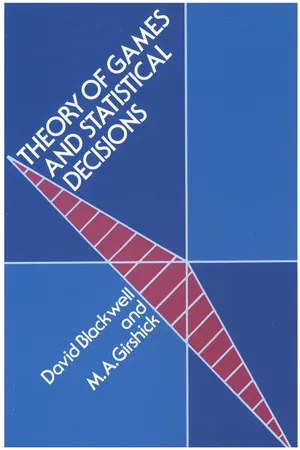
- 384 pages
- English
- ePUB (mobile friendly)
- Available on iOS & Android
Theory of Games and Statistical Decisions
About this book
Evaluating statistical procedures through decision and game theory, as first proposed by Neyman and Pearson and extended by Wald, is the goal of this problem-oriented text in mathematical statistics. First-year graduate students in statistics and other students with a background in statistical theory and advanced calculus will find a rigorous, thorough presentation of statistical decision theory treated as a special case of game theory.
The work of Borel, von Neumann, and Morgenstern in game theory, of prime importance to decision theory, is covered in its relevant aspects: reduction of games to normal forms, the minimax theorem, and the utility theorem. With this introduction, Blackwell and Professor Girshick look at: Values and Optimal Strategies in Games; General Structure of Statistical Games; Utility and Principles of Choice; Classes of Optimal Strategies; Fixed Sample-Size Games with Finite Ω and with Finite A; Sufficient Statistics and the Invariance Principle; Sequential Games; Bayes and Minimax Sequential Procedures; Estimation; and Comparison of Experiments.
A few topics not directly applicable to statistics, such as perfect information theory, are also discussed. Prerequisites for full understanding of the procedures in this book include knowledge of elementary analysis, and some familiarity with matrices, determinants, and linear dependence. For purposes of formal development, only discrete distributions are used, though continuous distributions are employed as illustrations.
The number and variety of problems presented will be welcomed by all students, computer experts, and others using statistics and game theory. This comprehensive and sophisticated introduction remains one of the strongest and most useful approaches to a field which today touches areas as diverse as gambling and particle physics.
Frequently asked questions
- Essential is ideal for learners and professionals who enjoy exploring a wide range of subjects. Access the Essential Library with 800,000+ trusted titles and best-sellers across business, personal growth, and the humanities. Includes unlimited reading time and Standard Read Aloud voice.
- Complete: Perfect for advanced learners and researchers needing full, unrestricted access. Unlock 1.4M+ books across hundreds of subjects, including academic and specialized titles. The Complete Plan also includes advanced features like Premium Read Aloud and Research Assistant.
Please note we cannot support devices running on iOS 13 and Android 7 or earlier. Learn more about using the app.
Information
CHAPTER 1
Games in Normal Form
1.1. Introduction

Table of contents
- Cover
- Title Page
- Copyright Page
- Dedication
- Contents
- 1 Games in Normal Form
- 2 Values and Optimal Strategies in Games
- 3 General Structure of Statistical Games
- 4 Utility and Principles of Choice
- 5 Classes of Optimal Strategies
- 6 Fixed Sample-Size Games with Finite Ω
- 7 Fixed Sample-Size Games with Finite A
- 8 Sufficient Statistics and the Invariance Principle in Statistical Games
- 9 Sequential Games
- 10 Bayes and Minimax Sequential Procedures When Both Ω and A Are Finite
- 11 Estimation
- 12 Comparison of Experiments
- References
- Index